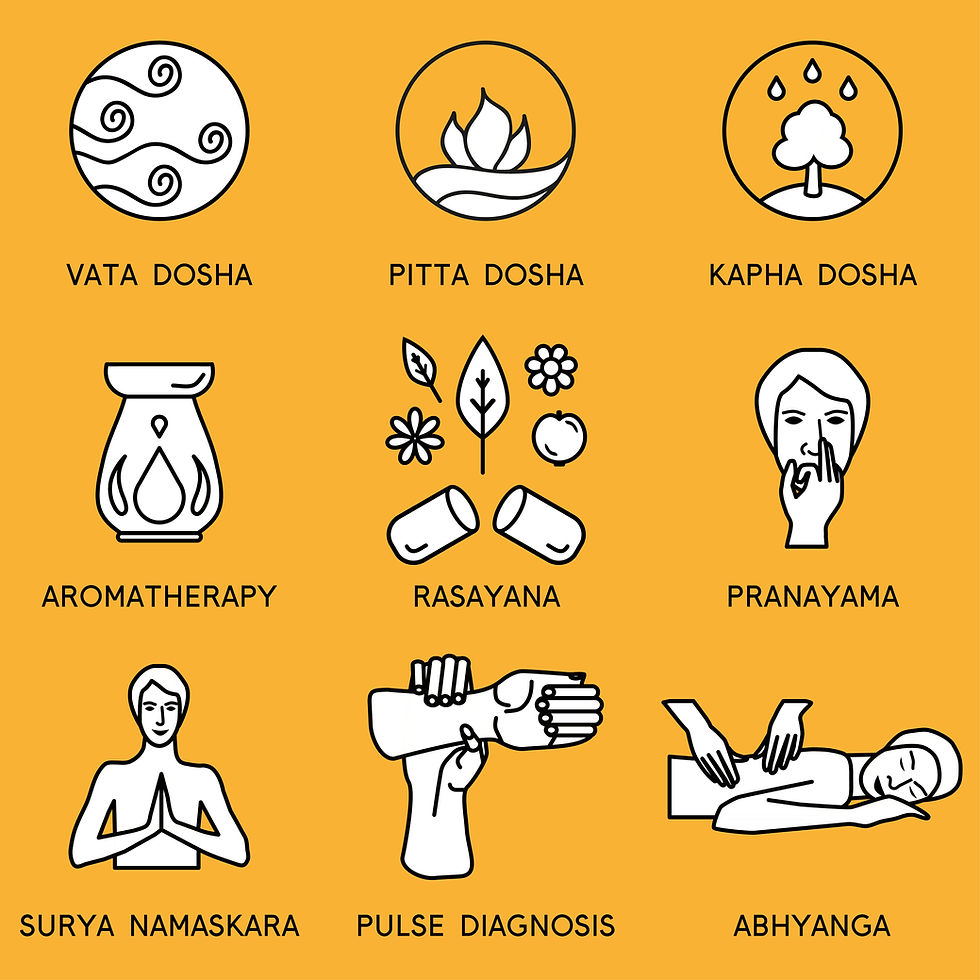Raja Yoga
- Jeff Perlman

- Oct 13
- 4 min read

Raja Yoga is often referred to as “Royal Yoga” or “Yoga of Kings.” Raja means king. Its original spelling, “Raaj,” actually implies control, ultimately referring to mastery over the self, body, mind, and breath. Raja yoga is one of the four main paths of yoga, all of which aim for enlightenment. Karma is the path of duty, Bhakti is the path of devotion, Jnana is the path of knowledge, and finally, Raja yoga is the path of self-control.
Around 450 BC, the sage Patanjali, with the assistance of his fellow Rishis (scholarly monks), compiled the Raja Yoga Sutras, documenting the path of Raja Yoga, known as the Yoga Sutras of Patanjali.
Yoga has many paths, branches, and Sanskrit terms with multiple meanings that can be confusing. It is a broad term that describes the philosophy or lifestyle developed by ancient gurus and yogis centuries ago, which incorporates asana, pranayama, and meditation, all of which move towards enlightenment.
Patanjali and the rishis of the time documented the eight limbs (steps) of yoga, which beliefs encompass most yoga paths, but are primarily rooted in Raja and Ashtanga yoga.
In yoga philosophy, Ashtanga Yoga refers to the “eight limbs,” outlining the eight steps practitioners take toward self-realization. However, in recent years, Ashtanga has been used to describe Ashtanga Vinyasa Yoga, a set of strictly structured asana sequences developed by Sri Pattabhi Jois in the 20th century.
When we refer to Ashtanga Yoga in the context of Raja, we do not mean the physical asana practice, but rather the ancient yoga philosophy of achieving enlightenment through the eight limbs documented in the Yoga Sutras.
I. Yamas- The Five Universal Moralities
Ahimsa- Non-Violence
Ahimsa means to cause no injury, physically or mentally, in one’s deeds, words, and thoughts toward others or to oneself. This is the way that Mahatma Gandhi lived and taught.
Satya- Absolute Truth
Satya universally means purity and absolute truth in our feelings, thoughts, words, and deeds. We must use this concept carefully to avoid harming others unnecessarily.
Asteya- Non-Stealing
This comes from the belief that we cannot provide what we need, and there is not enough for everyone. Here we are content with what comes to us in honest ways and not jealous of others.
Brahmacharya- Sense Control
Brahmacharya relates to how we use our sexual energy, not necessarily celibacy, but rather the forming of meaningful relationships with the highest connection to our spiritual selves.
Aparigraha- Freedom from Greed
This concept stems from a belief of non-possessiveness and directs us not to be jealous of others. This differs from Asteya, which is greed springing from a perceived lack of abundance.
II. Niyama- Five Personal Observances
Saucha- Purity and Cleanliness
This means maintaining physical cleanliness for our bodies and surroundings, mental purity of our minds, and avoiding the polluting of ourselves with negative emotional or physical obsessions.
Santosa- Contentment
Having a sense of modesty, humility, and peace brings a sense of contentment, accepting that there is a purpose for everything, and cultivating joy and compassion for all.
Tapas- Burning Desire
This refers to the physical process of heating and cleansing the body, as well as the enthusiastic engagement of our lives, with the goal of self-realization and creating union with the Divine.
Svadhyaya- Self-Study
Svadhyaya refers to self-examination, cultivating a self-reflective consciousness. It teaches us to be present, centered, and free of dualities and self-destructive tendencies.
Isvara Pranidhana- Surrender to God
This means “to lay all your actions at the feet of God.” This stage asks us to develop our relationship with the higher force that is guiding our lives and everything around us.
III. Asanas- Body Postures
The practice of mastering physical-body postures enhances physical strength, tones the body, purifies the blood, cultivates discipline, and sharpens the mind's focus.
IV. Pranayama- Control of the Breath
This is generally translated as control of the breath. This stage consists of mastering breathing techniques that tone the internal organs while connecting the breath, mind, and emotions.
V. Pratyahara- Withdrawal of the Senses
Withdrawing the senses from attachments to the external world and moving inwards. Here, we step back and take a look at ourselves, our cravings, habits, and obstacles that stand in the way of our inner growth.
VI. Dharana- Concentration
Dharana is a state of concentration and attention on a single mental object, an energetic center, a deity, or silent repetition of a sound, leading to concentration. The next step is focused immersion meditation.
VII. Dhyana- Meditation
Dhyana is a single-pointed focus with the sole purpose of attaining knowledge of the truth. Where Dharana is focused meditation practice, Dhyana is a state of being aware without a specific focus.
VIII. Samadhi- Union with the Divine
Samadhi is a state of bliss, where the practitioner merges with their point of focus, transcending the self completely, and makes the ultimate connection to the Divine, the universe, and all living things.



Comments